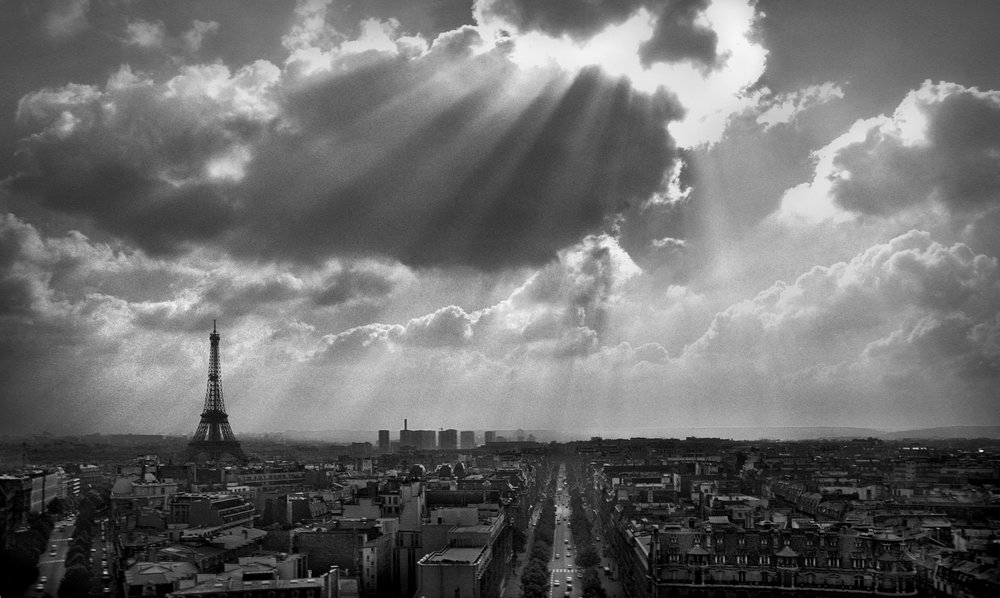
City of Light: With a reputation like that how can any photographer resist rushing off to photograph the entire city? The problem with Paris is that there is so much of it, so where do you begin? While I could not resist taking pictures of the famous sights, I tried wherever possible to also take a shot that was not a typical view. So while the Eiffel tower does make an appearance or two here, I’ve tried to make the pictures different from the usual postcard shots.
Living in Canada makes it a bit difficult to just “pop over” to Paris for some picture taking, but I was fortunate that my work brought me there half a dozen times over the years. Being there to work, the opportunities for photography were limited to weekends and evenings. Still, with a bit of planning, much can be accomplished in a few hours and with each visit, I set out to make the most of my time there.
I quickly found that the light in Paris is very different from that of Toronto. Somehow a bit more diffused, a bit warmer, and it lends itself very nicely to black and white photography. Even on an overcast day, the light works well for the photographer. The other delight for photographers who like urban landscape pictures is the way the broad avenues and much of the architecture in Paris provide leading lines that fit compositions so well.
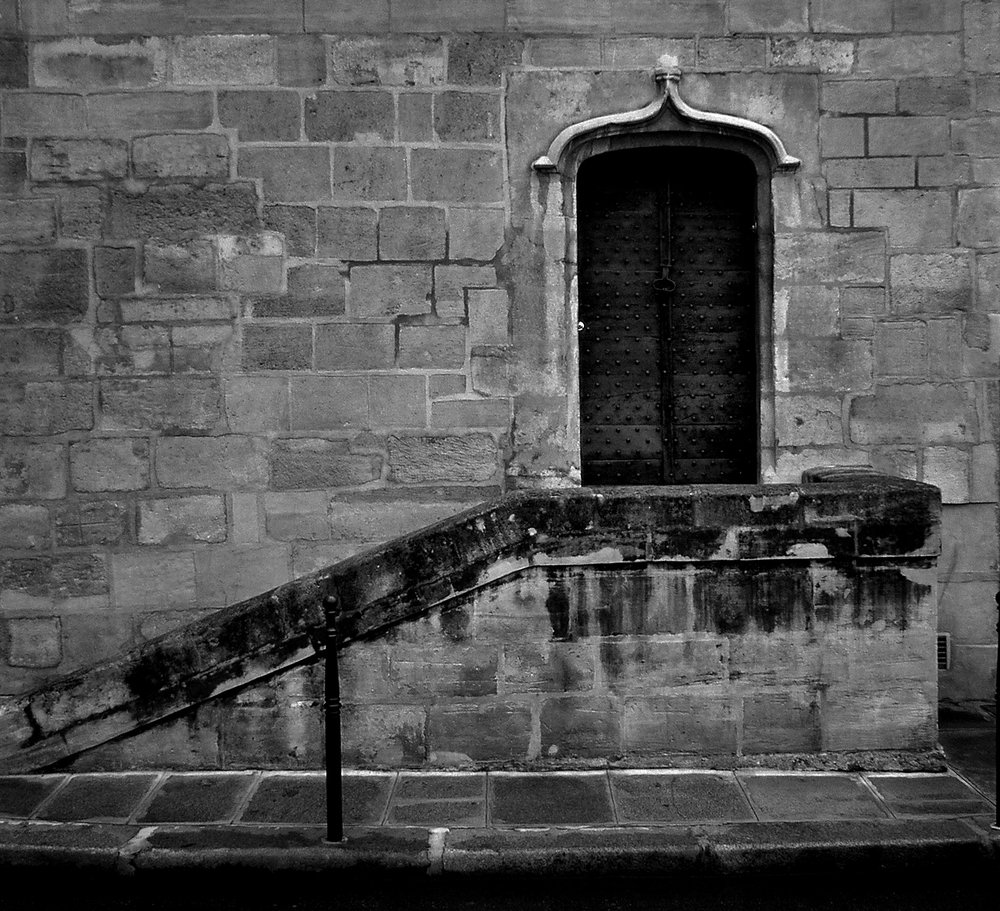
This was somewhere on the Isle de la Cite if I remember correctly. Taken with a Casio QV-R40 and converted to B&W. The Casio was a cheap little 4mp point-and-shoot but I was trying out digital for the first time and it fit the bill. There are so many back streets and small courtyards where the old and interesting can be found that you can spend days without looking at a single famous building.
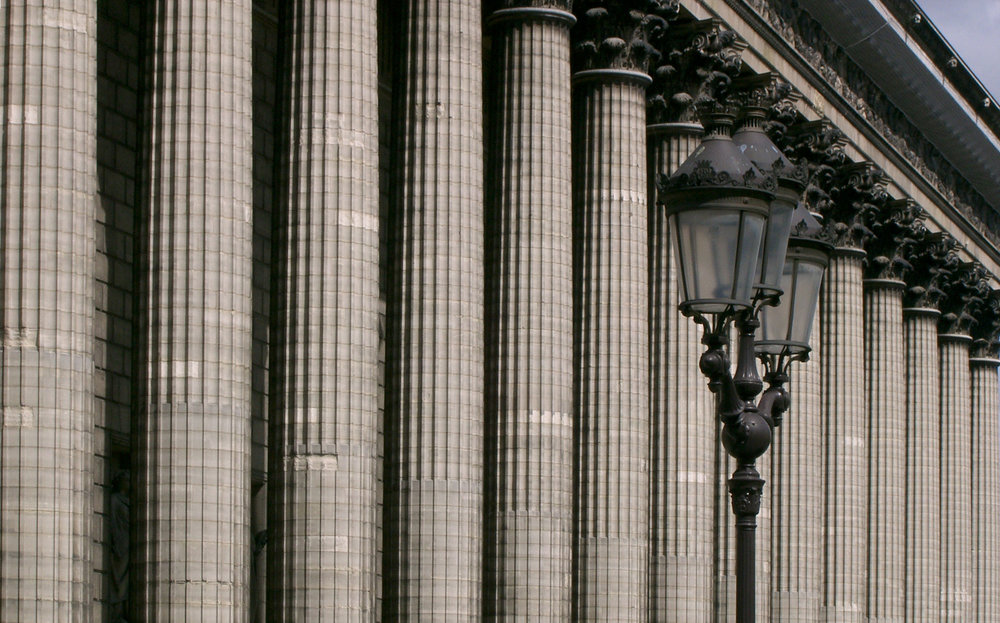
Then again, why not try to do something different with a famous building. This is Madeleine, a famous church in the centre of Paris. Taken with the Casio QV-R40. When I look at these photos, I am still surprised at how good 4mp can look.
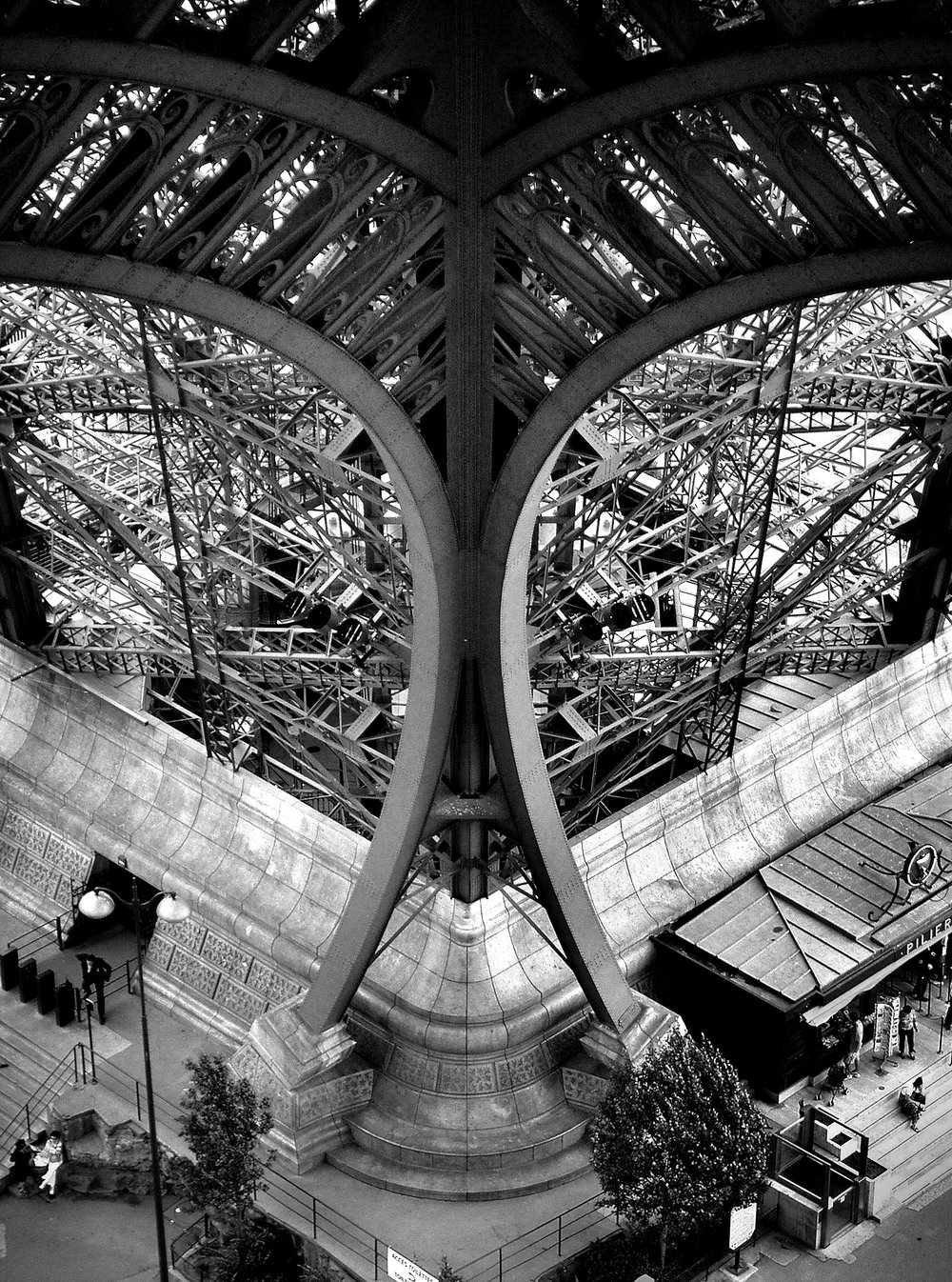
Casio QV-R40, converted to B&W. Looking down inside the “legs” of the Eiffel tower. I liked the almost organic looking curves of the steelwork and the way they lead the eye to the people at the edges of the frame.
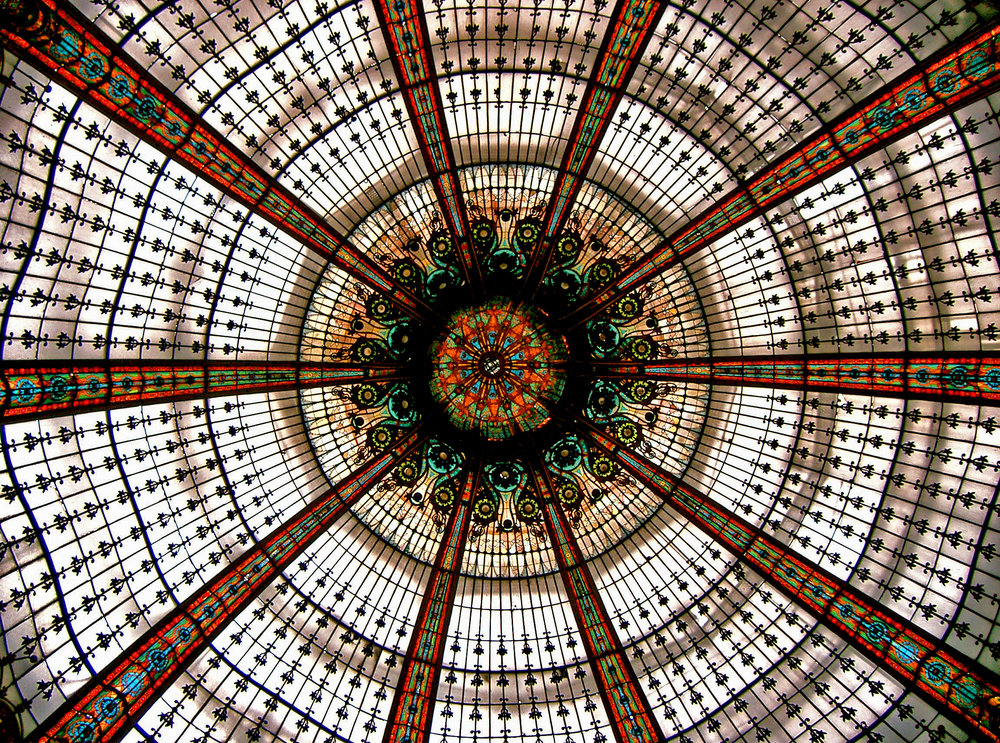
Casio QV-R40, Skylight in Galeries Lafayette, One of those “tourist shots” that John Shingleton dismisses as trivial. He’s quite right too, but I couldn’t resist all those leading lines.
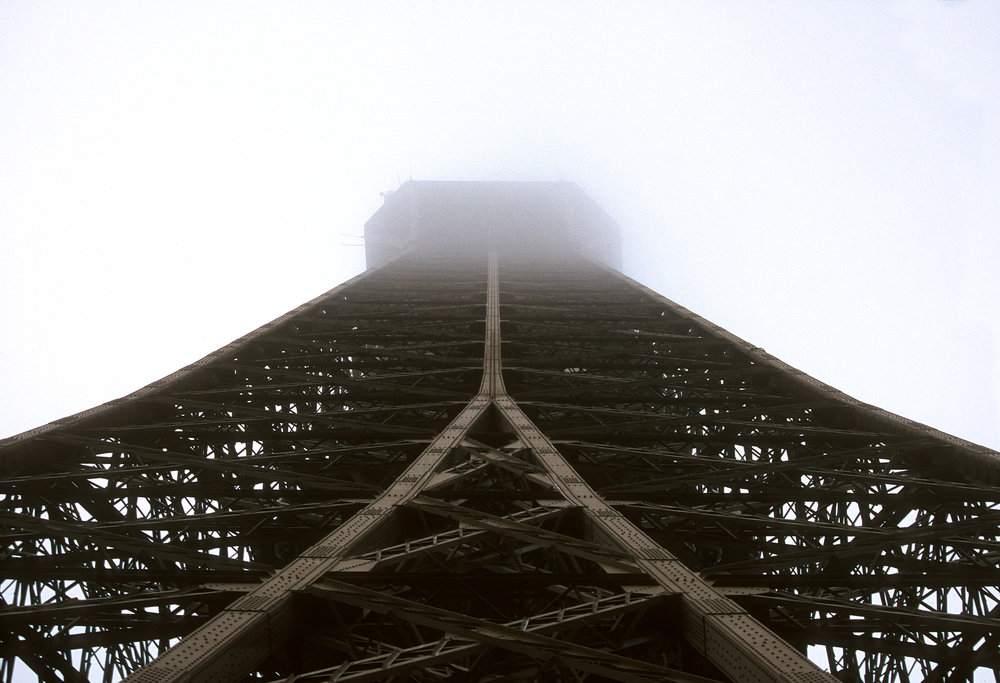
Taken from the first platform on the Eiffel tower. If I remember correctly, this was shot with a Leica M6, 35mm Summicron, on Ektachrome 160. The weather didn’t always cooperate, but it made a moody shot that was better than no shot at all.
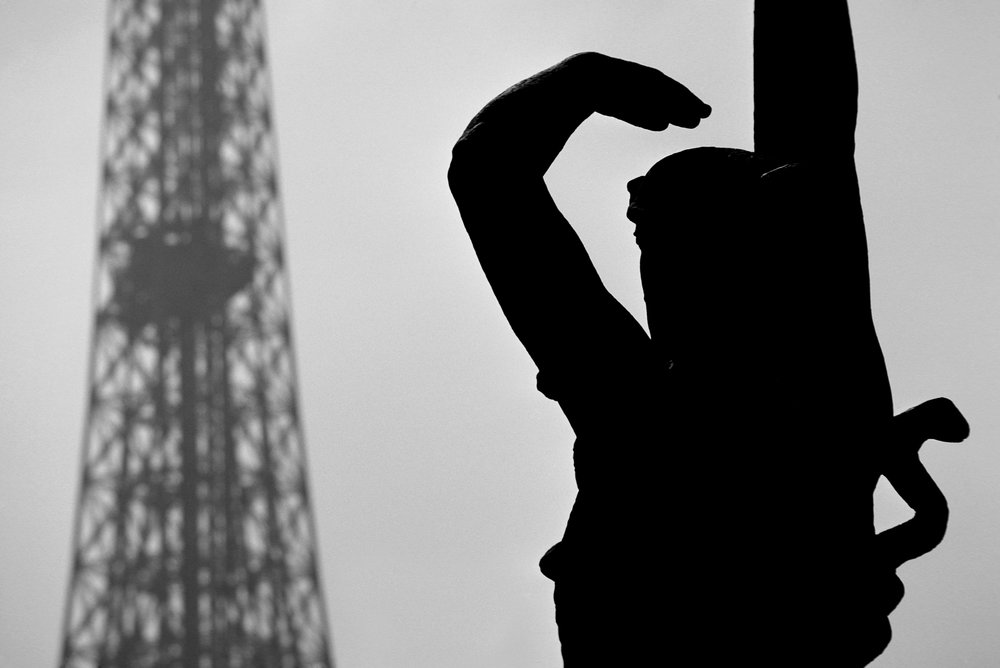
I can’t resist a visual joke, so a statue peering at the Eiffel tower in the distance was a natural. Taken with a Canon F1, 200mm f/2.8, Tri-X.
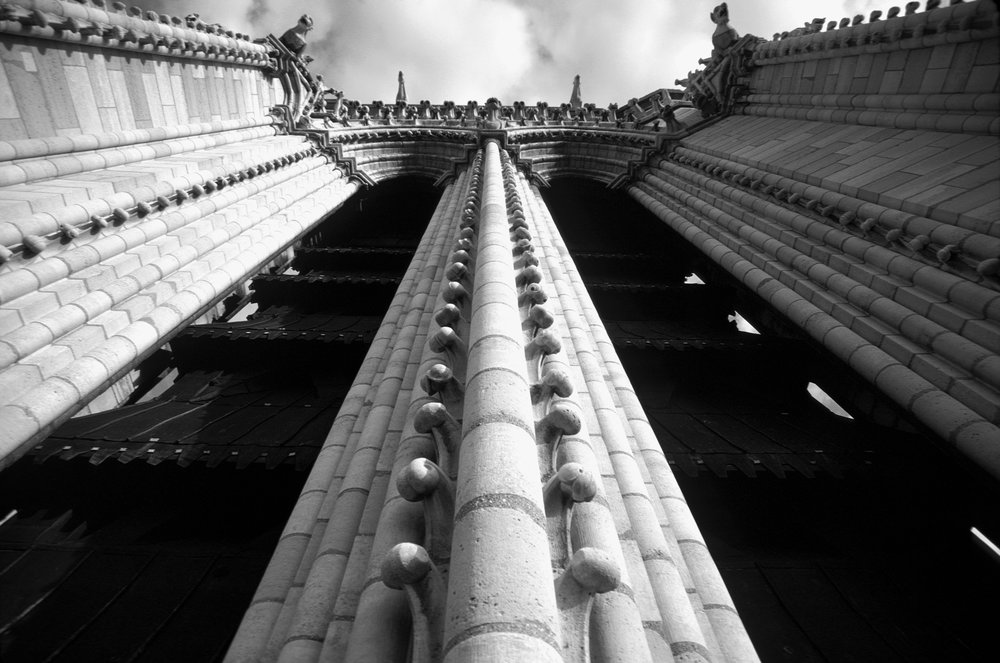
Notre Dame bell tower, taken while on the tour of the cathedral. I seem to have been on a bit of a roll with leading lines. Leica M6 classic (pre-TTL), 35mm Summicron.
I ran out of film so ferreted out a cheap Fuji print film I had bought while travelling and then scanned in B&W. It turned out to be a superb film, but I didn’t bother to take note of what it was.
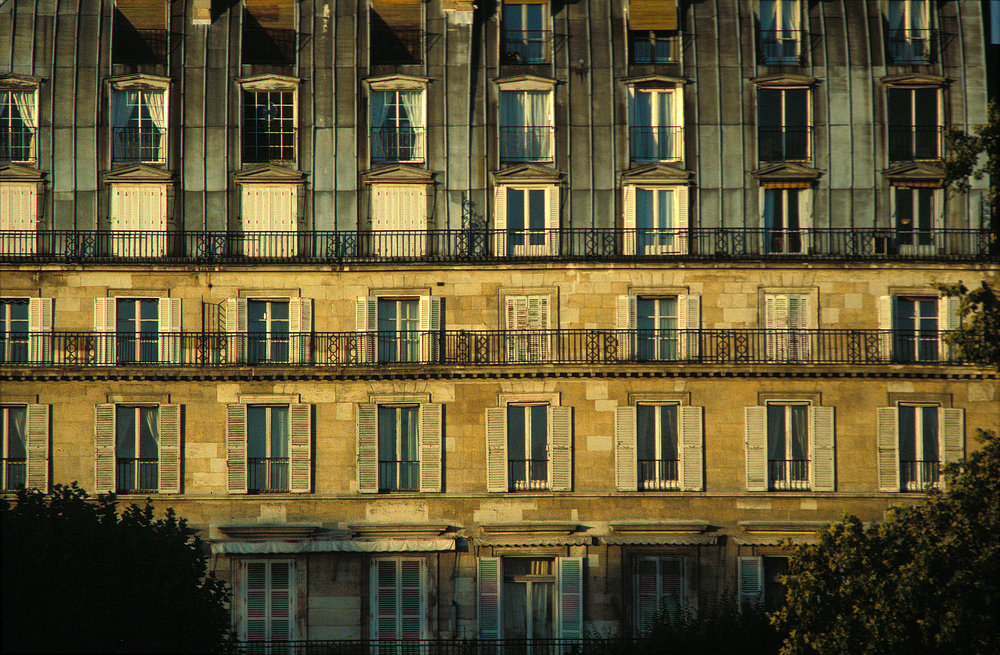
Apartments on the Rue De Rivoli taken from inside the Jardin des Tuileries. Leica M6 (pre-TTL), and an early 90mm Summicron.
The light was perfect. It’s not much of a picture, but the combination of the golden hour and the pattern of windows were too much to resist.
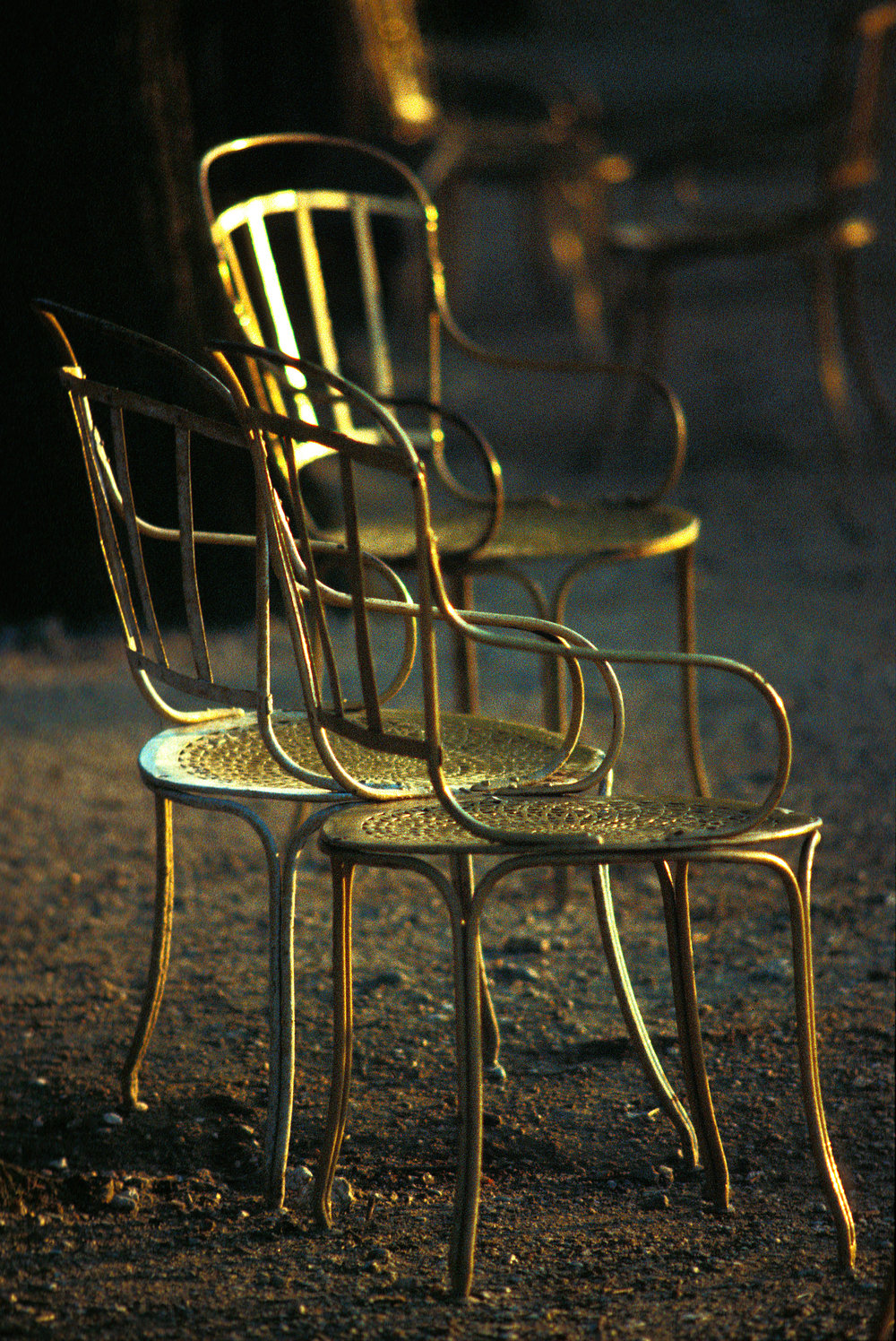
Chairs in the Jardin des Tuileries, golden hour. I like the feel of this shot even though it is a “postcard picture”. Leica M4, 50mm Summicron 1962 vintage, Kodachrome 64.
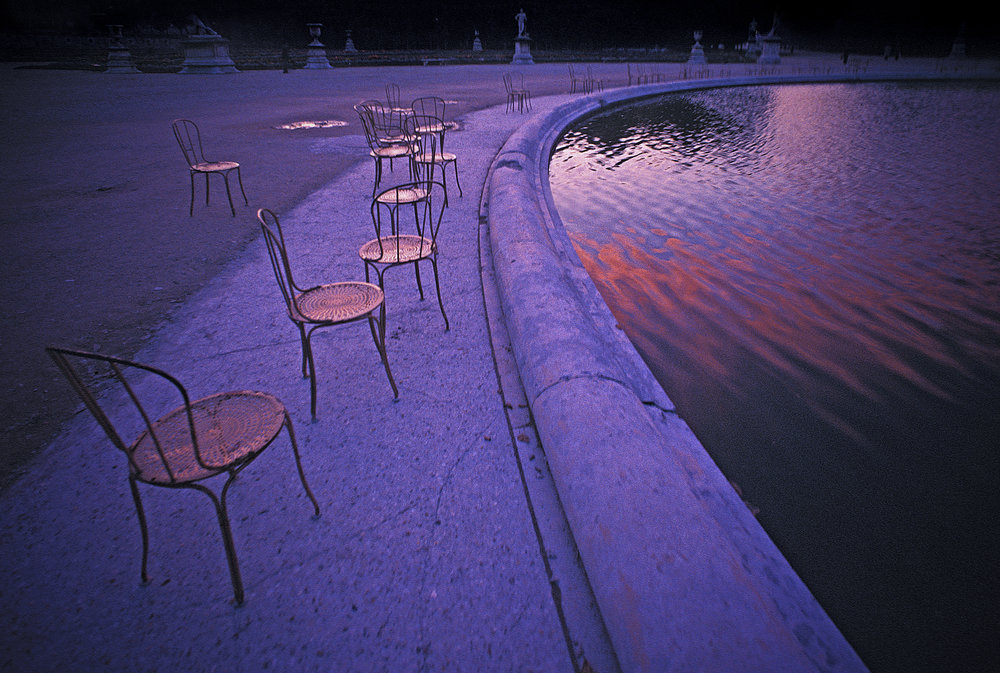
One of the ponds in the Jardin des Tuileries. Leica M4, early Elmarit 21mm (you can see by the corners that it’s not the ASPH version), Kodachrome 64.
Again the light was perfect. Taken during the blue hour with the last bit of lingering red cloud overhead, hence the colour of light.
A few years after taking this shot, my camera bag was stolen along with the M4, early 21mm Elmarit, early 35mm Summilux, and an old 50 ‘Lux. Insurance replaced the entire kit with the then current M6, 21mm Elmarit-M ASPH, 35mm Summilux ASPH, and 50mm Summilux, all brand new. I was very lucky as I could never have afforded to purchase this kit.
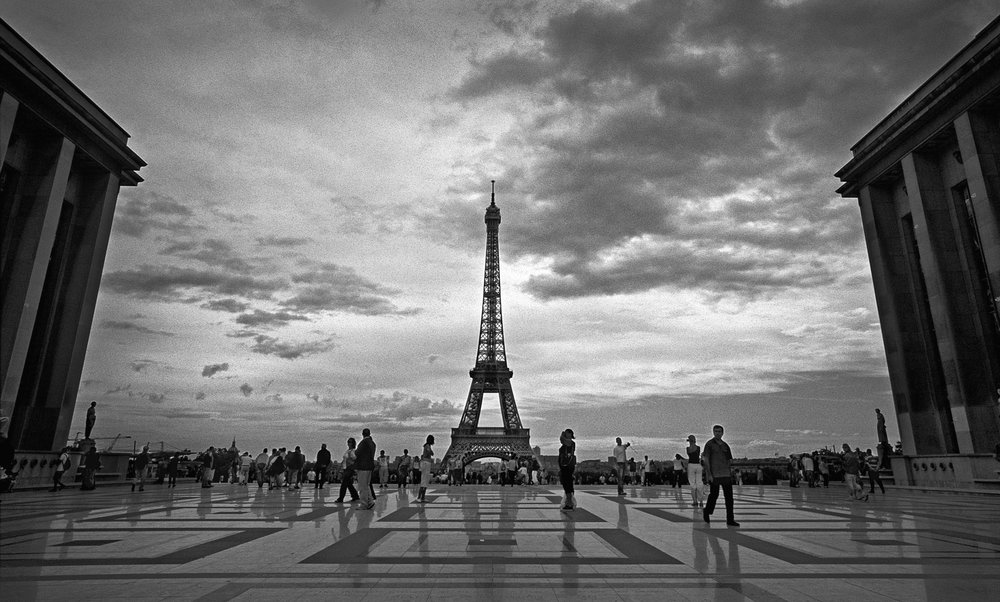
More leading lines. Leica M6 (pre-TTL), 21mm Elmarit-M ASPH, Tri-X.
Even when the sky is overcast, the clouds can look dramatic. This picture was taken as I walked a bit aimlessly around Paris. I passed by the square and all the people standing around caught my eye.
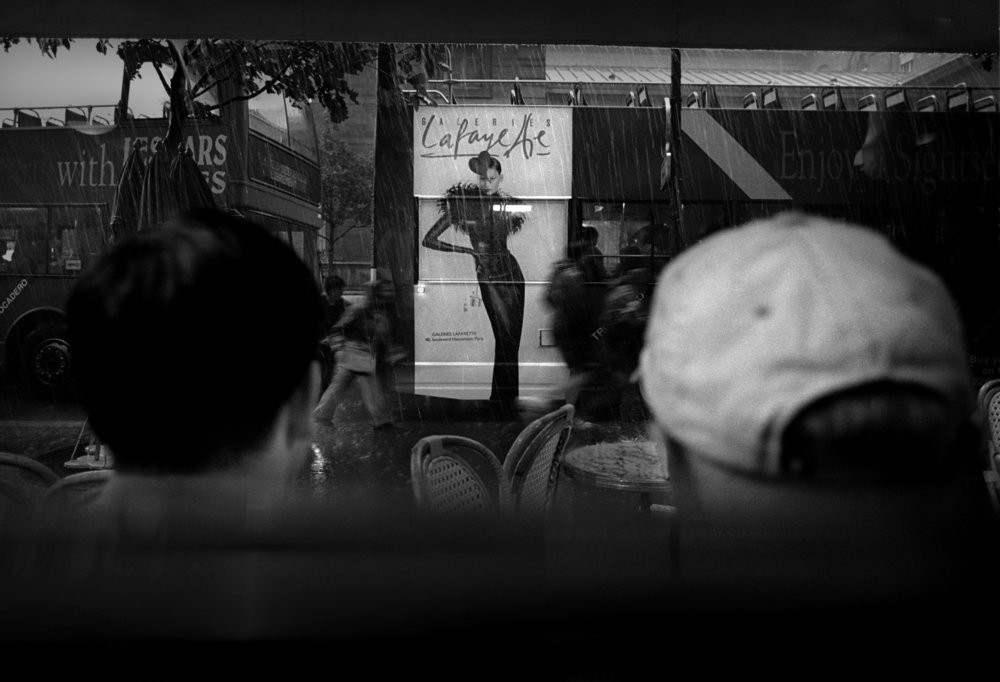
Ok, I do admit to photographing people and there are some wonderful characters in Paris to capture. These two studying the advert on the side of the bus made a nice symmetrical composition. No leading lines though. Leica M6, 35mm Summicron, Tri-X.
The rain was pelting down that day so I took a long lunch in a bistro to dry off a bit. Looking out the window I saw the scene above. They were so entranced by the advert, they had no idea I was there.
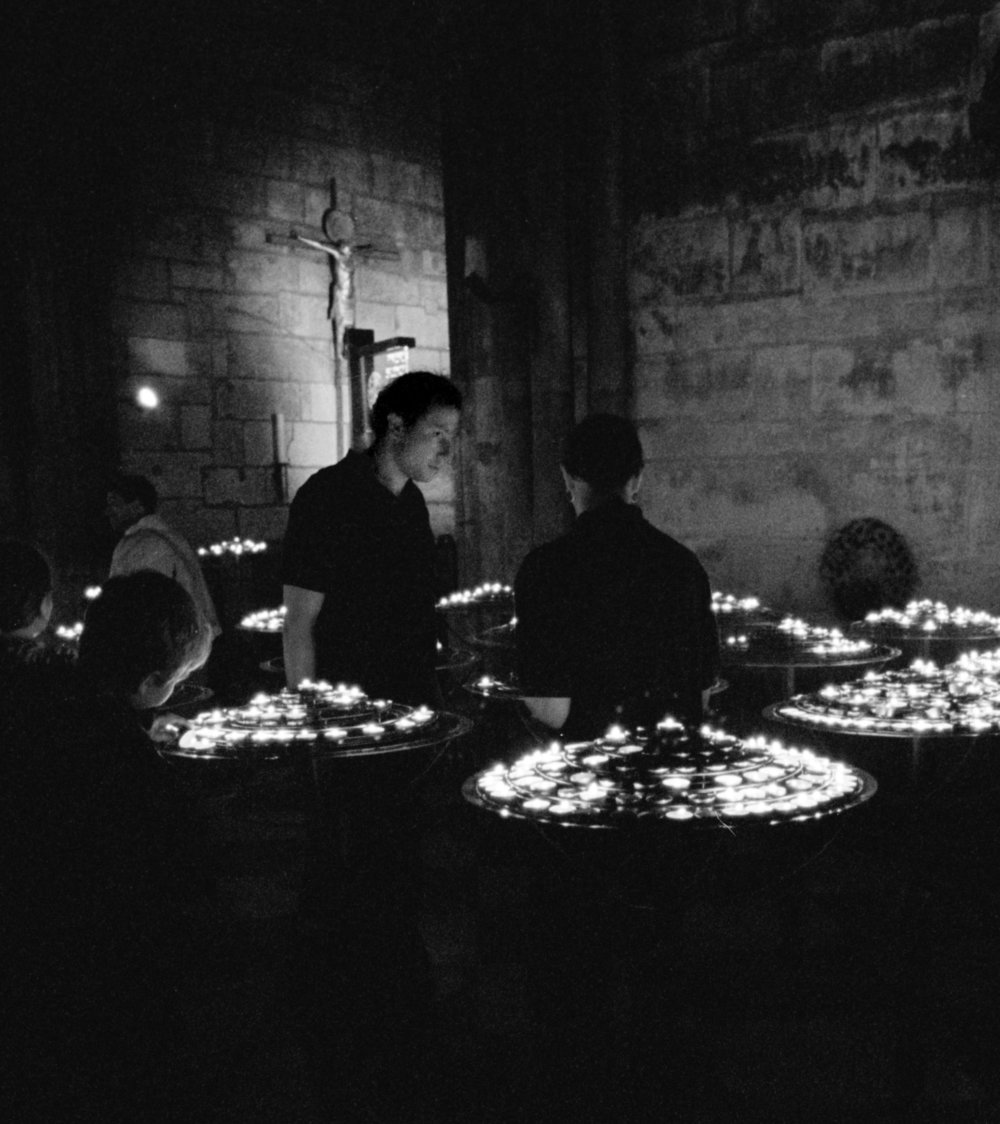
I didn’t realize that the inside of Notre Dame was so dark. Almost all the light came from the candles, so I believe this was taken at 1/8 second hand-held. I had steadier hands in those days. Leica M6, 35mm Summicron, Tri-X.
In addition to the Casio, I’ve shot a lot of film over the years in Paris, but the final disappearance of Kodachrome pushed me completely into digital photography for colour. I tried Velvia and several print films but none of them seemed to work for me. I continued with B&W photography on Tri-X for about five years, but eventually carrying a film camera for B&W and a digital for colour became too much for long distance travel. That was about the time the Leica M8 came out. Before that, I had been carrying a Canon DSLR and a Leica M6. The M8 was a significant improvement over the Canon 30d I was using and allowed me to significantly reduce the size and weight of my kit.
Since then I’ve moved through the M9 and then on to the Fuji X-Pro1 and then X-Pro2. The Fujis are capable of superb image quality and while the lenses are larger than equivalent Leica lenses, they don’t seem to be any heavier. In spite of that, I can’t quite seem to settle with the Fujis. There are too many options for me, both in the menus and in the form of buttons and dials on the body of the camera and I find the camera sometimes getting in the way. As soon as I can afford it I will be moving back to Leica with an M10, renewing my use of Leicas that started in 1976.
It’s been more than ten years since I was last in Paris, but it is a destination I will certainly visit many more times, and now that I am a 100% digital photographer, I hope to capture an even greater variety of shots. Using film, I found it very difficult to capture Paris at night, so that will be one of my first goals on my next trip.
_____________






Great story of what sounds like a great trip, Richard. Very interesting pics too. The Kodachrome 64 shots look gorgeous, interestingly with some obvious grain.
I wonder if the Casio ‘look’ is the 4mp, or if its the ccd sensor? I’m a bit of an adherent to the idea that ccd’s have a distinct look to them.
Thank you Jason. Regarding the ccd sensors, I agree. My M8 produced results, especially in B&W that I’ve never been able to reproduce with the Fuji. Then again, the M8 had a sensitivity about the same as Tri-X and the XPro2 low light performance is an order of magnitude better than that.
A nice set of images, and I enjoyed the journey of capturing them. I would welcome seeing future digital shots, and would love to hear about your future photographic journey – more so if you bag an M10, it is still dangling temptingly on my wish list – albeit a little beyond my means right now.
Dave
Hi Dave,
Thank you for your comments. I look forward to providing another story to Macfilos once I’ve captured a new set of Paris images. In the meantime look forward every week to your Flickr posts. Keep them coming!
Cheers Richard, I am currently doing Whitby by Fog, and I have a few Teesdale waterfall shots to publish once I am happy with the set – so there is some new stuff coming – plus I have another North Yorkshire trip planned and naturally some more shots from the area.
Dave
Bravo!!!Well done and highly appreciated.
Thank you!
I enjoyed the photos. "Touristy" or not, they are quite good.
Interesting that I have almost the same history of equipment usage. I was using a pair of M6’s when I added a Canon 30D for color and for the purpose of learning to deal with digital. It took a year or more with the Canon to become comfortable with digital, at which point I sold off all my Leicas. I then used various APS-C Canons mixed with 4/3 format for several years until I moved to Fuji a little over two years ago. I’ve since owned almost every model of Fuji, settling on the X-Pro1 and X-Pro2 as my main cameras (with a little support from the XT and X100 models).
I have been very happy with the Fujis. At my age with my eyesight, I benefit from AF and the Fuji’s AF is more than adequate for the subjects I’m interested in photographing. I thoroughly enjoy the OVF of the XPros. The bright frame lines remind me of the M6 with the added benefit of flipping a switch for a through-the-lens view when I need it. After an initially frustrating period of getting acquainted with the new camera system, I became totally comfortable with the Fuji operating system. The main thing I learned to do was turn off every feature I didn’t use and lock out all the buttons and dials that wasn’t necessary for the way I shoot pictures which is pretty much "kindergarten mode". I also found the XPro2 to be more complicated than the original model, however, as soon as I got my hands on mine I immediately went through the menus and did my turn off/lock out routine and it quickly simplified things.
Thank you. I appreciate hearing your experience with the XPro2. Coming from Leica, I also enjoy using the OVF of the XPro series, but I find that my fat fingers inevitably press some button I don’t want pressed at the worst possible time. Although I find the Fuji menus daunting, I will try your suggestions and see if I can turn everything off.
They are just superb images, all of them, and the way you have caught the light and shade is so satisfying! I am especially fascinated by the Casio shots. There is a quality to what we nowadays call "low resolution" that has its own vibrance – deeply pleasing. I sometimes take my Digilux 1 (also 4MP) for a walk, and its images have a quite painterly feel. I must try it more in mono.
John,
Thank you! You are too generous. I agree about the low resolution camera aesthetic. I wish I still had the Casio just to compare with something like the X-Pro 2, but alas the camera died quite a few years ago. Perhaps I can get the same effect by setting the Fuji resolution as low as possible? I must try that.
Lovely photos, Richard. Whether photos are tourist shots or not does not matter. Any photo taken while you are on holiday is going to be a tourist shot of some kind. Your photos do, however, capture Paris as you saw it and are really worth sharing. Most tourist shots nowadays are taken on phones and consist of somebody’s sister or wife or husband standing in front of something famous, which photo will be winging its way to Facebook or What’s App a couple of minutes later. When I was in Russia recently I saw a lot of this kind of thing, but the Russians themselves are past masters at this kind of thing. When I was in Rajasthan in India in 2009 a group of Russian ladies on our rail tour had their photo taken in front of everything famous such as the Taj Mahal and they had even brought along their own Russian native costumes to be photographed alongside with Indian people in their native costumes. Now that is real tourist photography.
Those chairs at the Jardin des Tuileries look familiar as we had chairs exactly the same as those in our back garden until recently. They now reside in my eldest daughter’s back garden. There must have been some plagiarism involved in the design of our garden chairs. Your shot of the chairs in the sunset is very evocative for us.
Finally on to the X-Pro 2. I have never had issues using my X-Pro 2. It has been getting a lot more use recently as my M10 is on its currently a ‘tourist’ in Wetzlar. I have an M240 but I find it to be clunky compared to either the X-Pro 2 or the M10. I operate on the basis that less than 10% of any menu is relevant whether it is in a camera, a phone or a micro-wave oven. I find the X-Pro 2 to be a delightfully simple camera to use when you stick to the basics of the camera. Menus are really only for restaurants and even there I stop reading a menu as soon as I see something I would like to eat.
William
Thank you William.
Your story about the Russian tourists is fascinating. I prefer to travel light, so I can’t imagine lugging costumes all over India just to have pictures take, but each to their own I guess. Regarding the X-Pro series, curiously I found I got on better with the first model, but I think the problem is all me. I’ve been a user of entirely mechanical cameras for so long I just can’t wrap my head around the Fujis. I even had the occasional issue using the M8 and that was a much simpler camera than the X-Pro 2. I hope I have better luck with the M10 or it’s back to film for me.
Richard, this is a great series of photos of my favourite subject, Paris. I certainly would not label your Galeries Lafayette photo touristy or trivial. OK not totally original but very well executed nonetheless.
Sadly you and I may have seen Paris at its best – my last visit was in 2014. We should count ourselves fortunate to have seen it and photographed it when we did.
John,
Thank you for your kind praise. I hope my next sortie to Paris once I can finally retire will produce pictures that can garner the same sort of praise. I hope you’re wrong about the Paris of today, as Mike says it’s been ten years since I was last there so I have no sense of what’s happened recently. It was a wonderful place to be, especially for a photographer. Nevertheless I intend to go back and widen the range of pictures I have made.